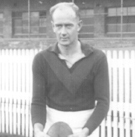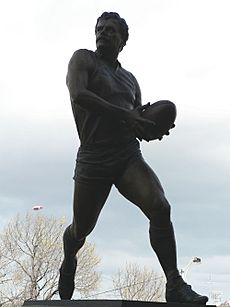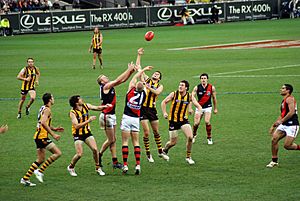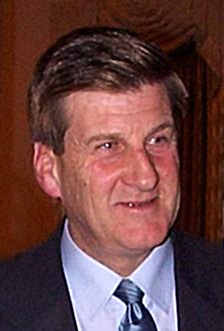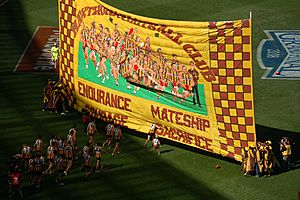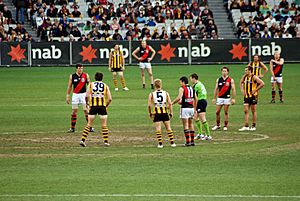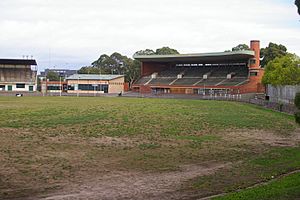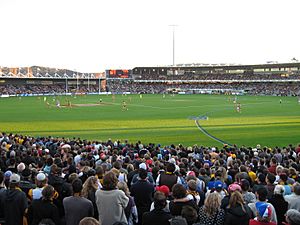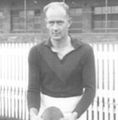Hawthorn Football Club facts for kids
Quick facts for kids Hawthorn Football Club |
||||
|---|---|---|---|---|
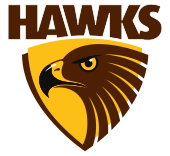 |
||||
| Names | ||||
| Full name | Hawthorn Football Club Limited | |||
| Nickname(s) | Hawks | |||
| Motto | Spectemur Agendo (Let us be judged by our acts.) | |||
| 2024 season | ||||
| After finals | 6th | |||
| Home-and-away season | 7th | |||
| Leading goalkicker | Mabior Chol (37 goals) | |||
| Peter Crimmins Medal | Jai Newcombe | |||
| Club details | ||||
| Founded | April 1902 (entered VFL in 1925) |
|||
| Colours | Brown Gold | |||
| Competition | AFL: Senior men AFLW: Senior women VBFL: Blind (mixed) VWFL: Wheelchair (mixed) CWFL: Wheelchair (mixed) |
|||
| President | Andrew Gowers | |||
| CEO | Ash Klein | |||
| Coach | Sam Mitchell | |||
| Captain(s) | James Sicily | |||
| Premierships | VFL/AFL (13)
|
|||
| Ground(s) | Melbourne Cricket Ground (capacity: 100,024) | |||
| University of Tasmania Stadium (capacity: 19,000) | ||||
| Former ground(s) | Glenferrie Oval (1906–1973) | |||
| Princes Park (1974–1991) | ||||
| Waverley Park (1974–1991) | ||||
| Training ground(s) | Waverley Park (until 2025) Kennedy Community Centre (from 2025) |
|||
| Uniforms | ||||
|
||||
| Other information | ||||
| Official website | hawthornfc.com.au | |||
The Hawthorn Football Club, also known as the Hawks, is a professional Australian rules football team. They are based in Mulgrave, Victoria, and play in the Australian Football League (AFL). The club started in 1902 in Hawthorn, making it the newest Victorian team in the AFL.
The Hawks are the only club to have won the VFL/AFL championship in every decade from the 1960s to the 2010s. They have won 13 premierships in total. The team wears traditional brown-and-gold striped guernseys for home games. For away games, they might wear gold, white, or brown guernseys.
The club's motto is in Latin: Spectemur agendo, which means "Let us be judged by our acts." The Hawks have strong rivalries with other AFL teams, especially the Geelong Cats and Essendon Bombers.
From their start until 1973, the Hawks played home games at Glenferrie Oval in Hawthorn. They then moved to Princes Park in 1974, staying there until 1991. After that, Hawthorn moved to Waverley Park. Later, the Melbourne Cricket Ground (MCG) became their main home ground when Waverley Park was redeveloped. The club's training and office facilities moved from Glenferrie to Waverley Park in 2006. Since 2007, Hawthorn has played four games a year at their second home ground, York Park in Launceston, Tasmania. Most other home games are at the MCG, with one usually at Marvel Stadium.
Hawthorn also has a women's team that plays in the AFLW competition. Their first AFLW game was on August 27, 2022, at Marvel Stadium. Tickets for that game sold out very quickly!
Contents
- Club History
- Season Summaries
- Club Symbols
- Corporate
- Rivalries
- Players
- Staff
- Club Honour Board
- Home Grounds and Training Base
- VFL Women's
- Reserves Team
- Under-19s
- Other Teams
- Images for kids
- See also
Club History
Early Years
Many people believe the club started in 1873, but the Hawthorn Football Club we know today is likely the third club with that name. Earlier Hawthorn clubs formed in 1873 and 1889, but both eventually stopped playing.
Modern Club Begins
In April 1902, a new club called the Hawthorn Football Club was formed by Alf Kosky. It joined the Metropolitan Junior Football Association (MJFA). Hawthorn won its first game in 1902 against Celtic. In 1905, Hawthorn merged with the Boroondara Football Club and changed its colours to black with a red sash.
In 1906, the club became the Hawthorn City Football Club when Glenferrie Oval opened. In 1912, they merged with the Hawthorn Rovers, changing their colours again to gold with a blue "V". The club then joined the Victorian Football Association (VFA) in 1914.
VFA Years: 1914–1924
When they joined the VFA, Hawthorn had to change their colours again because Williamstown already used blue and gold. They chose brown and gold, which they still wear today. The team, nicknamed the Mayblooms, struggled at first.
In 1922, Bill Walton became their captain-coach. Hawthorn almost made the finals in 1922 and then did reach the finals in 1923, but lost to Port Melbourne.
Joining the VFL
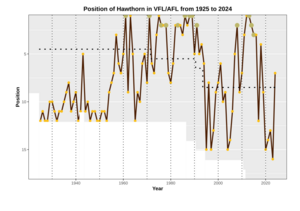
The VFL wanted to add more teams. In 1924, a group worked to get Hawthorn into the VFL. On January 16, 1925, the VFL decided to add Hawthorn, Footscray, and North Melbourne to the league.
Tough Times: 1925–1949
For many years, the Mayblooms were not very successful. They often finished at the bottom of the ladder. They couldn't even pay their players much money.
In 1942, coach Roy Cazaly suggested changing the nickname to the "Hawks". He thought it sounded tougher than "Mayblooms." In 1943, the Hawks had their best season yet, almost making the finals. However, they soon returned to the bottom of the ladder. In 1949, Col Austen tied for the Brownlow Medal, but didn't win it at the time due to old rules. He was later given the medal in 1989.
The 1950s
The 1950s started with some disagreements within the club. In 1950, the team didn't win any games. They also changed their playing jumper to the brown and gold vertical stripes we see today.
Important players like John Kennedy and Roy Simmonds joined the club. Kennedy was captain from 1955 to 1959 and won the club's Best and Fairest award four times.
In 1952, Jack Hale became coach. He helped the club become more serious about winning. Even though they finished last in 1953, the team steadily improved after that.
Young talents like John Peck, Allan Woodley, Noel Voigt, Brian Kann, Graham Arthur, and Brendan Edwards joined the Hawks.
First Finals Appearance
In 1957, the senior team made it to the finals for the very first time! They beat Carlton in a semi-final game that people still remember because of a strange hailstorm. They were then defeated by Melbourne in the next final.
The Kennedy Era: 1960–1982
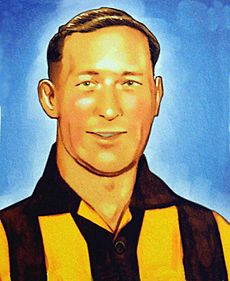
Winning Championships
| 1961 VFL Grand Final | G | B | Total |
| Hawthorn | 13 | 16 | 94 |
| Footscray | 7 | 9 | 51 |
| Venue: Melbourne Cricket Ground | Crowd: 107,935 | ||
John Kennedy returned as coach in 1960. He made the players train much harder. In 1961, Kennedy led the Hawks to their first-ever premiership, beating Footscray.
The team struggled in 1962 but finished first in 1963, only to lose the Grand Final to Geelong. Graham Arthur became captain-coach in 1964.
In 1967, John Kennedy returned as coach. New players like Don Scott and Peter Hudson joined. Hudson became a star goal-kicker, scoring over 100 goals in 1968 and 1969. The club also gained access to a strong recruiting area, bringing in talented players like Peter Knights and Leigh Matthews in 1969.
In 1971, the Hawks finished first on the ladder. Peter Hudson equaled a record with 150 goals, and Leigh Matthews won his first club championship.
| 1971 VFL Grand Final | G | B | Total |
| Hawthorn | 12 | 10 | 82 |
| St Kilda | 11 | 9 | 75 |
| Venue: Melbourne Cricket Ground | Crowd: 118,192 | ||
The 1971 VFL Grand Final was a tough game against St Kilda. Hawthorn was behind by 20 points at the last quarter. But the Hawks, known as "Kennedy's Commandos" for their tough training, scored seven goals to three in the final quarter to win the premiership!
In 1972, Michael Tuck played his first game for Hawthorn. He would go on to play a club record 426 games.
| 1976 VFL Grand Final | G | B | Total |
| Hawthorn | 13 | 22 | 100 |
| North Melbourne | 10 | 10 | 70 |
| Venue: Melbourne Cricket Ground | Crowd: 110,143 | ||
During the 1970s, a strong rivalry grew with North Melbourne. They played in three Grand Finals, with Hawthorn winning two. The 1976 VFL Grand Final win was especially meaningful. It came just three days before former captain Peter Crimmins passed away from cancer.
| 1978 VFL Grand Final | G | B | Total |
| Hawthorn | 18 | 13 | 121 |
| North Melbourne | 15 | 13 | 103 |
| Venue: Melbourne Cricket Ground | Crowd: 101,704 | ||
In the 1978 VFL Grand Final, Hawthorn again played North Melbourne. Hawthorn won by three goals after a strong third quarter.
Glory Years: 1983–1991
Seven Straight Grand Finals: 1983–1989
The 1980s were Hawthorn's most successful time. They won four premierships and played in the Grand Final seven years in a row. This included three Grand Finals against their big rival, Essendon. Allan Jeans became coach in 1982.
| 1983 VFL Grand Final | G | B | Total |
| Hawthorn | 20 | 20 | 140 |
| Essendon | 8 | 9 | 57 |
| Venue: Melbourne Cricket Ground | Crowd: 110,332 | ||
Hawthorn won their first premiership of the decade in the 1983 VFL Grand Final, beating Essendon by a record margin at the time. They lost to Essendon in the 1984 VFL Grand Final and 1985 VFL Grand Final.
| 1986 VFL Grand Final | G | B | Total |
| Hawthorn | 16 | 14 | 110 |
| Carlton | 9 | 14 | 68 |
| Venue: Melbourne Cricket Ground | Crowd: 101,861 | ||
Their second premiership of the 1980s came in the 1986 VFL Grand Final, where they beat Carlton. In 1987, Hawthorn lost the Grand Final to Carlton.
| 1988 VFL Grand Final | G | B | Total |
| Hawthorn | 22 | 20 | 152 |
| Melbourne | 6 | 20 | 56 |
| Venue: Melbourne Cricket Ground | Crowd: 93,754 | ||
In 1988, Alan Joyce coached the team. Hawthorn lost only three games all year and won the 1988 VFL Grand Final against Melbourne by a huge margin.
| 1989 VFL Grand Final | G | B | Total |
| Hawthorn | 21 | 18 | 144 |
| Geelong | 21 | 12 | 138 |
| Venue: Melbourne Cricket Ground | Crowd: 94,796 | ||
The 1989 VFL Grand Final against Geelong is considered one of the greatest games ever. It was a very tough and high-scoring match. Hawthorn won by just one goal, even though many of their players were injured during the game.
1990–1991
Hawthorn continued their success into the early 1990s. In 1991, they won the pre-season cup. Despite a big loss in the first game of the season, the team bounced back.
| 1991 AFL Grand Final | G | B | Total |
| Hawthorn | 20 | 19 | 139 |
| West Coast | 13 | 8 | 86 |
| Venue: Waverley Park | Crowd: 75,230 | ||
The 1991 AFL Grand Final was special because it was the only one played at Waverley Park and featured the first non-Victorian team, West Coast. Hawthorn won their fifth premiership in nine seasons. This was Michael Tuck's last game, and he retired with many records, including 426 games played.
A New Era: 1992–2004
After their amazing success, Hawthorn faced some challenges. They moved all their home games to Waverley Park in 1992. The club also started having financial problems. Many key players left, and the team struggled on the field.
Almost a Merger
In 1996, the club almost merged with the Melbourne Demons to form a new team called the "Melbourne Hawks." However, many Hawthorn supporters, led by former champion Don Scott, strongly voted against it, and the merger did not happen. This led to a new board taking over the club.
The Alastair Clarkson Era: 2005–2021
Building a Strong Team: 2005–2006
In 2005, Alastair Clarkson became the new coach. He focused on building a young team. The Hawks drafted future stars like Jarryd Roughead, Lance Franklin, and Jordan Lewis. In 2005, Hawthorn won only five games but showed promise with their young players. Luke Hodge had a great season, winning the club's best and fairest award.
In 2006, the club moved its main offices and training facilities to Waverley Park. Clarkson also introduced new playing strategies.
Return to Finals and Premiership: 2007–2008
In 2007, the Hawks improved a lot, winning 13 games and making the finals. They won their first final but were knocked out in the next game. Clarkson also brought in new players like Stuart Dew and Cyril Rioli. He also introduced a new defensive strategy called the "Clarkson Cluster."
| 2008 AFL Grand Final | G | B | Total |
| Hawthorn | 18 | 7 | 115 |
| Geelong | 11 | 23 | 89 |
| Venue: Melbourne Cricket Ground | Crowd: 100,012 | ||
In 2008, Hawthorn played a tough, physical style of football. They finished second on the ladder and went on to win the 2008 AFL Grand Final against Geelong. Geelong had only lost one game all season, so it was a big upset! Lance Franklin won the Coleman Medal for kicking 102 goals that year.
Challenges and Changes: 2009–2010
After the 2008 premiership, Hawthorn faced new challenges. Key players retired or were injured. The team finished ninth in 2009, missing the finals. In 2010, they had a slow start but changed their playing style to focus more on accurate kicking. This helped them win more games and make the finals, though they lost their first final.
A Dynasty of Success: 2011–2016
In 2011, Hawthorn finished third on the ladder but lost a close preliminary final. Lance Franklin won another Coleman Medal. In 2012, Hawthorn finished first, but lost the 2012 AFL Grand Final to the Sydney Swans.
| 2013 AFL Grand Final | G | B | Total |
| Hawthorn | 11 | 11 | 77 |
| Fremantle | 8 | 14 | 62 |
| Venue: Melbourne Cricket Ground | Crowd: 100,007 | ||
In 2013, Hawthorn again finished first. Jarryd Roughead won the Coleman Medal. They won their 11th premiership by defeating the Fremantle Dockers in the 2013 AFL Grand Final.
| 2014 AFL Grand Final | G | B | Total |
| Hawthorn | 21 | 11 | 137 |
| Sydney | 11 | 8 | 74 |
| Venue: Melbourne Cricket Ground | Crowd: 99,460 | ||
In 2014, Hawthorn won their 12th premiership. They beat the Sydney Swans in the 2014 AFL Grand Final, getting revenge for their 2012 loss.
| 2015 AFL Grand Final | G | B | Total |
| Hawthorn | 16 | 11 | 107 |
| West Coast | 8 | 13 | 61 |
| Venue: Melbourne Cricket Ground | Crowd: 98,632 | ||
In 2015, Hawthorn won their third premiership in a row, beating the West Coast Eagles in the 2015 AFL Grand Final. This was their 13th overall flag. In 2016, the Hawks made the finals again but were knocked out by the Western Bulldogs.
Final Years of Clarkson: 2017–2021
In 2017, Jarryd Roughead became captain. The team struggled early in the season but improved greatly in the second half, just missing the finals. Tom Mitchell had an amazing season, breaking records for possessions.
In 2018, Tom Mitchell won the Brownlow Medal. The team surprised many by finishing fourth and making the finals. In 2019, Mitchell broke his leg and missed the whole season, and the Hawks finished ninth. In 2020, they finished 15th.
On July 6, 2021, it was announced that Sam Mitchell would take over as head coach from Alastair Clarkson in 2023. However, this plan changed, and Clarkson left at the end of the 2021 season, with Mitchell becoming coach immediately.
Historical Allegations (2022)
In September 2022, the club looked into past concerns about how some Indigenous players were treated. The AFL also started its own independent investigation into these matters.
The Sam Mitchell Era (2022-Present)
Hawthorn finished 13th in 2022 and 16th in 2023. However, they showed signs of improvement.
In 2024, Hawthorn had an incredible season. They started with five losses but then lost only five more games for the rest of the year. They made the finals for the first time since 2018, finishing seventh. This was a remarkable comeback!
The Hawks beat the Western Bulldogs in the elimination final. Their amazing journey ended in a very close semi-final loss to Port Adelaide by just three points.
Season Summaries
Here are the results for Hawthorn's last five seasons. For all their season results, see List of Hawthorn Football Club seasons.
| Season | Won | Lost | Drawn | Position | Finals | Coach | Captain | Leading goalkicker |
Peter Crimmins Medal |
| 2020 | 5 | 12 | 0 | 15th | Did not qualify | Alastair Clarkson | Ben Stratton | Jack Gunston | Jack Gunston |
| 2021 | 7 | 13 | 2 | 14th | Did not qualify | Alastair Clarkson | Ben McEvoy | Luke Breust | Tom Mitchell |
| 2022 | 8 | 14 | 0 | 13th | Did not qualify | Sam Mitchell | Ben McEvoy | Luke Breust | James Sicily |
| 2023 | 7 | 16 | 0 | 16th | Did not qualify | Sam Mitchell | James Sicily | Luke Breust | Will Day |
| 2024 | 14 | 9 | 0 | 7th | Lost semi-final (Port Adelaide) 72–75 | Sam Mitchell | James Sicily | Mabior Chol | Jai Newcombe |
Club Symbols
Logo, Crest and Mascot
When Hawthorn joined the VFL in 1925, their nickname was The Mayblooms, named after the hawthorn bush. In 1943, coach Roy Cazaly suggested the new nickname "Hawks", thinking it sounded tougher.
| Official Logo |
|---|
|
Hawthorn's first official logo came out in 1977. It was a gold shield with a "Flying Hawk" holding a brown football with "HFC" on it. |
|
In 1982, the club adopted the famous "Hawk Head" logo. This logo was popular because the club won many premierships while using it. |
|
After almost merging with another club in 1996, Hawthorn introduced a new "Flying Hawk" logo in 1997. This new logo helped the club gain many more members. |
| On October 6, 2007, the club launched its current logo. It looks similar to the "Hawk Head" from the 80s and 90s. The eye and beak of the hawk represent the club's "determination, pride, and focus." |
The Hawks' mascot is Hudson "Hawka" Knights, a hawk dressed like a Hawthorn player.
Club Guernsey
Hawthorn's main colours are brown and gold vertical stripes, which they have worn since 1950. Their current main sponsors include Tasmania, iiNet, Bupa, Nissan, and Adidas.
The club's colours and designs have changed a few times over the years:
- 1914–1924: Brown with a gold circle around the neck and "HFC" in the middle.
- 1925–1932: Brown with a gold V and a smaller "HFC" on the left chest.
- 1933–1934: Gold with a brown V.
- 1934–1949: Brown with a gold V and brown socks with gold tops.
- 1950–1974: Brown and gold stripes on the front and back, with black numbers on a white panel.
- 1975–1988: Brown and gold stripes with a plain gold back and brown numbers.
- 1989–1997: Brown and gold stripes with a plain gold back and brown numbers, with plain gold socks.
- 1998–2005: Brown and gold stripes with a plain gold back and brown numbers.
- 2006–2012: Brown and gold stripes on the front and back, with black numbers on a white panel.
- 2013–present: Brown and gold stripes on the front and back, with brown numbers on a gold panel.
In 2018, Hawthorn's president said that the club's clash guernseys would no longer have white, because "White is the colour of surrender, and at Hawthorn we never surrender."
Club Song
The Hawthorn club song is called "We're a Happy Team at Hawthorn." It uses the tune of "The Yankee Doodle Boy" from a 1904 musical. The song was adapted with new Hawthorn lyrics in 1956.
Corporate
New Training Centre
Hawthorn is building a large new headquarters in Dingley. This new facility will be called the Kennedy Community Centre, named after former player and coach John Kennedy Sr.
Construction started in February 2024. The first stage will include a community pavilion, an AFLW oval with seating, and the Harris Elite Training and Administration Facility. This facility will have an indoor training field, a high-performance gym, and aquatic facilities. When finished, Hawthorn will be the only team to own its own facility and the land it's on. The club plans to move into the new centre in the second half of 2025.
Connection with Tasmania
Since 2001, Hawthorn has built a strong fan base in Tasmania. Their membership there has grown from 1,000 to over 9,000. Hawthorn plays four games a year in Tasmania as part of a deal with the Tasmanian government. This partnership helps both the club and Tasmania's economy. The agreement has been renewed several times and continues until 2027.
Reconciliation Plan
On July 19, 2019, Hawthorn launched its reconciliation plan. This plan aims to help the club connect more with Aboriginal and Torres Strait Islander cultures.
Club Support
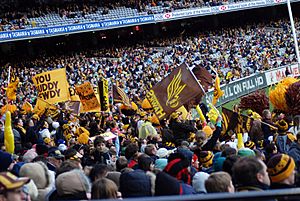
Hawthorn has a huge fan base across Australia, especially in Victoria and Tasmania. They are one of the top clubs for drawing crowds to games at the MCG, often averaging over 50,000 fans for their home games.
The club's success in the 1970s and 1980s helped them gain many supporters. In 2009, Hawthorn became the first Victorian club to reach over 51,000 members. By 2012, they were the second club to have over 60,000 members. In 2024, Hawthorn had 83,823 members.
Rivalries
Essendon – Hawthorn and Essendon had a big rivalry in the 1980s, playing in three Grand Finals in a row. These games were very competitive. More recently, games between them have seen some big on-field clashes, showing their rivalry is still strong.
Geelong – The rivalry with Geelong is famous for the 1989 and 2008 Grand Finals. In the 1989 VFL Grand Final, Hawthorn won a very tough and high-scoring game. In the 2008 AFL Grand Final, Hawthorn caused a big upset by beating Geelong, who had only lost one game all season.
After 2008, Geelong won eleven games in a row against Hawthorn. Many of these were very close games, often decided by less than 10 points. This losing streak for Hawthorn was nicknamed the "Kennett curse" after comments made by Hawthorn's president. The "curse" was finally broken in the 2013 Preliminary Final when Hawthorn won by five points.
North Melbourne – Hawthorn and North Melbourne have a rivalry that goes back to the 1970s. They played each other in three Grand Finals in four years. Both teams joined the VFL in 1925 and became very strong in the 1970s, leading to their rivalry.
Sydney Swans – This rivalry is more recent, starting around 2011. The clubs have met in two Grand Finals. In 2012, the Swans upset Hawthorn to win the premiership. The rivalry grew when Hawthorn star Lance Franklin moved to the Swans in 2013. In 2014, Hawthorn got their revenge, beating the Swans by a large margin in the Grand Final.
Port Adelaide - A newer rivalry has grown in the last few years. In Round 10, 2024, Hawthorn lost to Port Adelaide by just one point after giving up a big lead. This tension increased in the 2024 Semi Final, where Hawthorn lost by three points. After that game, there was a public disagreement between Port Adelaide's coach and Hawthorn's captain. In Round 5 of 2025, another intense game saw multiple on-field clashes between the teams.
Players
Current Squad
| Senior list | Rookie list | Coaching staff | |||||||
|---|---|---|---|---|---|---|---|---|---|
|
|
|
Head coach
Assistant coaches
Updated: 20 July 2025 |
||||||
Guernsey Retirement
After the 1976 season, Hawthorn retired guernsey number 5 to honor former captain Peter Crimmins, who passed away. The number stayed retired until 1993, when Peter's widow chose a new player to wear it. Since then, the Crimmins family chooses who wears number 5.
On March 6, 2011, the club announced that guernsey number 1 would be retired as a player number and given as a tribute to the fans. However, on December 7, 2018, the number was un-retired, and Harry Morrison was chosen to wear it.
Staff
Coaching Staff
| Coach | Assistant Coaches | Development Coaches | General Manager – Football Operations |
|---|---|---|---|
| Sam Mitchell |
|
|
|
Officials
| President | Vice President | Directors | CEO | General Managers |
|---|---|---|---|---|
| Andrew Gowers | Katie Hudson |
|
Ash Klein |
|
Club Honour Board
Achievements
| Premierships | |||
| Competition | Level | Wins | Years Won |
|---|---|---|---|
| Australian Football League | Seniors | 13 | 1961, 1971, 1976, 1978, 1983, 1986, 1988, 1989, 1991, 2008, 2013, 2014, 2015 |
| Reserves (1919–1999) | 4 | 1958, 1959, 1972, 1985 | |
| Under 19s (1946–1991) | 1 | 1972 | |
| VFL Women's | Seniors | 1 | 2018 |
| Other Titles and Honours | |||
| Championship of Australia | Seniors | 1 | 1971 |
| McClelland Trophy | Multiple | 9 | 1961, 1971, 1984, 1985 (tied), 1986, 1988, 2012, 2013, 2024 |
| VFL Night Series | Seniors | 3 | 1968, 1969, 1977 |
| NFL Night Series | Seniors | 1 | 1976 |
| AFC Night Series | Seniors | 2 | 1985, 1986 |
| AFL Pre-Season Competition | Seniors | 4 | 1988, 1991, 1992, 1999 |
| Victorian Junior Football Association | Reserves | 1 | 1924 |
| Victorian Blind Football League | Seniors (Hawthorn) | 1 | 2019, 2024 |
| Seniors (Brown) | 1 | 2023 | |
| Victorian Wheelchair Football League | Seniors | 1 | 2023 |
| Finishing Positions | |||
| Australian Football League | Minor Premiership | 9 | 1961, 1963, 1971, 1975, 1986, 1988, 1989, 2012, 2013 |
| Grand Finalist | 6 | 1963, 1975, 1984, 1985, 1987, 2012 | |
| Wooden Spoons | 11 | 1925, 1927, 1928, 1932, 1941, 1942, 1946, 1949, 1950, 1953, 1965 | |
- Hawthorn is the only club in the VFL/AFL to have won Senior Premierships in the 1960s, 1970s, 1980s, 1990s, 2000s and 2010s.
VFL/AFL Grand Finals
| Date | Coach | Captain | Opponent | Score | Venue | Attendance | Norm Smith Medal |
|---|---|---|---|---|---|---|---|
| 23-Sep-1961 | John Kennedy Sr. | Graham Arthur | Footscray | 13.16 (94) – 7.9 (51) | Melbourne Cricket Ground | 107,935 | |
| 05-Oct-1963 | John Kennedy Sr. | Graham Arthur | Geelong | 8.12 (60) – 15.19 (109) | Melbourne Cricket Ground | 101,209 | |
| 25-Sep-1971 | John Kennedy Sr. | David Parkin | St Kilda | 12.10 (82) – 11.9 (75) | Melbourne Cricket Ground | 118,192 | |
| 27-Sep-1975 | John Kennedy Sr. | Don Scott | North Melbourne | 9.13 (67) – 19.8 (122) | Melbourne Cricket Ground | 110,551 | |
| 23-Sep-1976 | John Kennedy Sr. | Don Scott | North Melbourne | 13.22 (100) – 10.10 (70) | Melbourne Cricket Ground | 110,143 | |
| 30-Sep-1978 | David Parkin | Don Scott | North Melbourne | 18.13 (121) – 15.13 (103) | Melbourne Cricket Ground | 101,704 | |
| 24-Sep-1983 | Allan Jeans | Leigh Mathews | Essendon | 20.20 (140) – 8.9 (57) | Melbourne Cricket Ground | 110,332 | Colin Robertson |
| 29-Sep-1984 | Allan Jeans | Leigh Mathews | Essendon | 12.9 (81) – 14.21 (105) | Melbourne Cricket Ground | 92,865 | Billy Duckworth (ESS) |
| 28-Sep-1985 | Allan Jeans | Leigh Mathews | Essendon | 14.8 (92) – 26.14 (170) | Melbourne Cricket Ground | 100,042 | Simon Madden (ESS) |
| 27-Sep-1986 | Allan Jeans | Michael Tuck | Carlton | 16.14 (110) – 9.14 (68) | Melbourne Cricket Ground | 101,861 | Gary Ayres |
| 26-Sep-1987 | Allan Jeans | Michael Tuck | Carlton | 9.17 (71) – 15.14 (104) | Melbourne Cricket Ground | 92,754 | David Rhys-Jones (CAR) |
| 24-Sep-1988 | Alan Joyce | Michael Tuck | Melbourne | 22.20 (152) – 6.20 (56) | Melbourne Cricket Ground | 93,754 | Gary Ayres |
| 30-Sep-1989 | Allan Jeans | Michael Tuck | Geelong | 21.18 (144) – 21.12 (138) | Melbourne Cricket Ground | 94,796 | Gary Ablett Sr. (GEE) |
| 28-Sep-1991 | Alan Joyce | Michael Tuck | West Coast | 20.19 (139) – 13.8 (86) | Waverley Park | 75,230 | Paul Dear |
| 27-Sep-2008 | Alastair Clarkson | Sam Mitchell | Geelong | 18.7 (115) – 11.23 (89) | Melbourne Cricket Ground | 100,012 | Luke Hodge |
| 29-Sep-2012 | Alastair Clarkson | Luke Hodge | Sydney | 11.15 (81) – 14.7 (91) | Melbourne Cricket Ground | 99,683 | Ryan O'Keefe (SYD) |
| 28-Sep-2013 | Alastair Clarkson | Luke Hodge | Fremantle | 11.11 (77) – 8.14 (62) | Melbourne Cricket Ground | 100,007 | Brian Lake |
| 27-Sep-2014 | Alastair Clarkson | Luke Hodge | Sydney | 21.11 (137) – 11.8 (74) | Melbourne Cricket Ground | 99,454 | Luke Hodge |
| 3-Oct-2015 | Alastair Clarkson | Luke Hodge | West Coast | 16.11 (107) – 8.13 (61) | Melbourne Cricket Ground | 98,632 | Cyril Rioli |
Australian Football Hall of Fame
Hawthorn has 26 people in the Australian Football Hall of Fame (23 players, 3 coaches) who played or coached for the club.
Bold means they have "Legend" status.
| Hawthorn Football Club Hall of Famers | |||||||||
|---|---|---|---|---|---|---|---|---|---|
| Players | |||||||||
| Name | Years | Games | Goals | Inducted | Name | Years | Games | Goals | Inducted |
| Graham Arthur | 1955–1968 | 232 | 201 | 1996 | Albert Chadwick | 1929 | 17 | 8 | 1996 |
| Peter Hudson | 1967–1974 1977 |
129 | 727 | 1996 | Peter Knights | 1969–1985 | 264 | 201 | 1996 |
| Leigh Matthews | 1969–1985 | 332 | 915 | 1996 | Dan Minogue | 1926 | 1 | 2 | 1996 |
| Michael Tuck | 1971–1991 | 426 | 320 | 1996 | Gary Ayres | 1978–1993 | 269 | 70 | 1999 |
| Dermott Brereton | 1982–1992 | 189 | 427 | 1999 | Don Scott | 1967–1981 | 302 | 133 | 2001 |
| Jason Dunstall | 1985–1998 | 269 | 1,254 | 2002 | John Platten | 1986–1998 | 258 | 228 | 2003 |
| Gary Ablett Sr. | 1981–1983 | 6 | 10 | 2005 | Kelvin Moore | 1970–1984 | 300 | 21 | 2005 |
| Robert DiPierdomenico | 1975–1991 | 240 | 130 | 2007 | Darren Jarman | 1991–1995 | 109 | 122 | 2007 |
| Chris Langford | 1983–1997 | 300 | 33 | 2009 | Shane Crawford | 1992–2008 | 305 | 224 | 2012 |
| Rick Davies | 1981 | 20 | 37 | 2013 | Paul Salmon | 1996–2000 | 100 | 41 | 2016 |
| Terry Wallace | 1978–1986 | 174 | 96 | 2018 | Sam Mitchell | 2002–2016 | 307 | 67 | 2023 |
| Luke Hodge | 2002–2017 | 305 | 193 | 2025 | |||||
| Coaches | |||||||||
| Name | Years | Games | Wins | Inducted | Name | Years | Games | Wins | Inducted |
| Allan Jeans | 1981–1987 1989–1990 |
221 | 159 | 1996 | John Kennedy Sr. | 1957 1960–1963 1967–1976 |
299 | 181 | 1996 |
| David Parkin | 1977–1980 | 94 | 57 | 2002 | |||||
Hawthorn Football Club Hall of Fame
Here is a list of everyone who has been inducted into the club's own Hall of Fame.
Bold means they have "Legend" status.
- Alec Albiston
- Graham Arthur
- Gary Ayres
- Dermott Brereton
- Gary Buckenara
- Brian Coleman
- Andrew Collins
- Ron Cook
- Shane Crawford
- Peter Crimmins
- Ian Dicker
- Robert DiPierdomenico
- Jason Dunstall
- Rodney Eade
- Brendan Edwards
- Max Elmer
- Dr. A.S. Ferguson
- Ken Goddard
- Russell Greene
- Jack Hale
- Luke Hodge
- Peter Hudson
- Bert Hyde
- Allan Jeans
- Dr. J. Jona
- Brian Kann
- John Kennedy Jr.
- John Kennedy Sr.
- J.W. Kennon
- Peter Knights
- Chris Langford
- Ian Law
- Alan Martello
- Leigh Matthews
- Chris Mew
- Harry E. Miller
- Bert Mills
- Sam Mitchell
- Kelvin Moore
- John O'Mahony
- David Parkin
- John Peck
- John Platten
- Ted Pool
- Darrin Pritchard
- Phil Ryan
- Don Scott
- Bob Sellers
- Roy Simmonds
- Stan Spinks
- Michael Tuck
- Ern Utting
- Terry Wallace
- W. 'Beau' Wallace
Home Grounds and Training Base
Hawthorn has had four main home grounds: Glenferrie Oval, Princes Park, Waverley Park, and the Melbourne Cricket Ground.
Glenferrie Oval: (Home Games 1906–1973), (Training and Offices 1906–2006)
Glenferrie Oval was the club's traditional home. Its location helped the club join the VFA in 1914 and the VFL in 1925. The oval was expanded and improved over the years. The famous art-deco Grandstand, built in 1937, is now called the Michael Tuck stand.
The club stopped playing VFL matches here in 1973 because of growing crowds. However, it remained the club's training and office base until 2006. Glenferrie Oval is still used for special club events, like premiership celebrations.
Princes Park: 1974–1991
Moving to Princes Park, the home of the Carlton Football Club, was a big change. This move happened during Hawthorn's most successful period, as they won many premierships while playing there. Even though they had great success, many Hawthorn fans didn't like the move because it was far from their traditional area.
Waverley Park: (Home Games 1992–1999), (Training and Offices 2006–Present)
In 1990, Hawthorn started playing some home games at Waverley Park. They moved all their home games there in 1992. The club saw more fans and members at Waverley. When the AFL closed Waverley Park for redevelopment, Hawthorn decided to move its home games to the MCG. In January 2006, the club's offices and training moved back to Waverley Park.
Melbourne Cricket Ground: 2000–Present
On March 13, 2000, Hawthorn played its first home game as an MCG tenant. Since then, Hawthorn has played most of its home games at the MCG. They also play some games at Docklands Stadium and York Park in Tasmania.
York Park: 2001–Present
Since 2001, Hawthorn has played "secondary" home games at York Park (also known as The University of Tasmania Stadium) in Tasmania. The Hawks have a very good record there. This agreement has helped Hawthorn gain many fans in Tasmania.
VFL Women's
Hawthorn has a women's team that plays in the VFL Women's (VFLW) competition. The team is linked with the Box Hill Hawks.
| 2018 VFLW Grand Final | G | B | Total |
| Hawthorn | 4 | 6 | 30 |
| Geelong | 2 | 5 | 17 |
| Venue: Etihad Stadium | Crowd: 10,000 est. | ||
In 2018, the Hawthorn women's team won the VFLW premiership, beating Geelong. The VFLW team often plays before the Box Hill men's team, giving fans a chance to support both.
Reserves Team
| Hawthorn | ||
|---|---|---|
 |
||
| Names | ||
| Full name | Hawthorn Football Club Limited | |
| 1999 season | ||
| Home-and-away season | 10th | |
| Club details | ||
| Founded | 1924 | |
| Dissolved | 1999 | |
| Competition | AFL reserves | |
| Premierships | VFL/AFL reserves (7)
|
|
| Ground(s) | Waverley Park | |
| Former ground(s) | Princes Park | |
| Uniforms | ||
|
||
The Hawthorn reserves team used to play in the AFL reserves competition until it ended.
Since 2000, Hawthorn has been connected with the Box Hill Football Club in the Victorian Football League. This means Hawthorn players not chosen for the AFL team can play for Box Hill. Box Hill has won three premierships since this partnership began.
History of the Reserves
Hawthorn's first reserves team played in 1924. Their first championship was in 1958, and they won again in 1959. Their third premiership was in 1972, and their fourth was in 1985.
Under-19s
1972 Championship
| 1972 VFL Grand Final Under-19s | G | B | Total |
| Hawthorn | 13 | 23 | 101 |
| North Melbourne | 13 | 20 | 98 |
| Venue: Melbourne Cricket Ground | |||
Hawthorn also had a team in the VFL Under-19s competition. They won a Grand Final in 1972 against North Melbourne.
Other Teams
Hawthorn has a team in the Victorian Blind Football League (VBFL). They won the 2019 premiership. In 2023, Hawthorn had two VBFL teams, Hawthorn Gold and Hawthorn Brown, with Brown winning the Grand Final against Gold. In 2024, they returned to having a single Hawthorn team.
Images for kids
-
Chart of yearly ladder positions for Hawthorn in VFL/AFL
-
John Kennedy Sr. was the Hawks' first premiership coach. Hawthorn honored him with a bronze statue at Waverley Park.
-
Statue of former Hawthorn player, Leigh Matthews, at the Melbourne Cricket Ground.
-
Supporters of Hawthorn at the MCG.
See also
 In Spanish: Hawthorn Football Club para niños
In Spanish: Hawthorn Football Club para niños


